Going Up: I'd assign this at most a 20% possibility. There is just too much bad news out there. Also consider today's GDP announcement and its lack of impact on the markets. If that news had come at the beginning of an economic expansion, the markets would probably have exploded. Instead we got a very lackluster response. I think the markets know that number is yesterday's news and the economy is going into a weaker period. In addition, there is a ton of bad news out there. This week's housing news was terrible and indicated we're nowhere near bottom. And the durable goods number was another bad number.
As I hope I note often, the market will make an ass out of you whenever possible. And the market has a million ways to do that on a regular basis.
In my defense I will note I wrote that before Bernanke's Thursday night speech where he made this comment:
The incoming data on economic activity and prices will help to shape the Committee’s outlook for the economy; however, the outlook has also been importantly affected over the past month by renewed turbulence in financial markets, which has partially reversed the improvement that occurred in September and October. Investors have focused on continued credit losses and write-downs across a number of financial institutions, prompted in many cases by credit-rating agencies’ downgrades of securities backed by residential mortgages. The fresh wave of investor concern has contributed in recent weeks to a decline in equity values, a widening of risk spreads for many credit products (not only those related to housing), and increased short-term funding pressures. These developments have resulted in a further tightening in financial conditions, which has the potential to impose additional restraint on activity in housing markets and in other credit-sensitive sectors. Needless to say, the Federal Reserve is following the evolution of financial conditions carefully, with particular attention to the question of how strains in financial markets might affect the broader economy.
On Friday the markets interpreted these comments as supporting further rate cuts at the next Fed meeting. As a result, the markets gapped higher at the open. In other words, my prediction that the upside potential was 20% wasn't spot on (to say the least).
Let's look at last week's charts to see what happened.

The SPY's formed a double bottom on Tuesday. They gapped higher on Wednesday, consolidated in a triangle pattern on Thursday and gapped higher at the open on Friday. They also closed on Friday with a rally on heavy volume. This indicates traders were willing to hold positions over the weekend. This tells us traders are less concerned about bad news happening over the last few days (which it hasn't in any meaningful way).
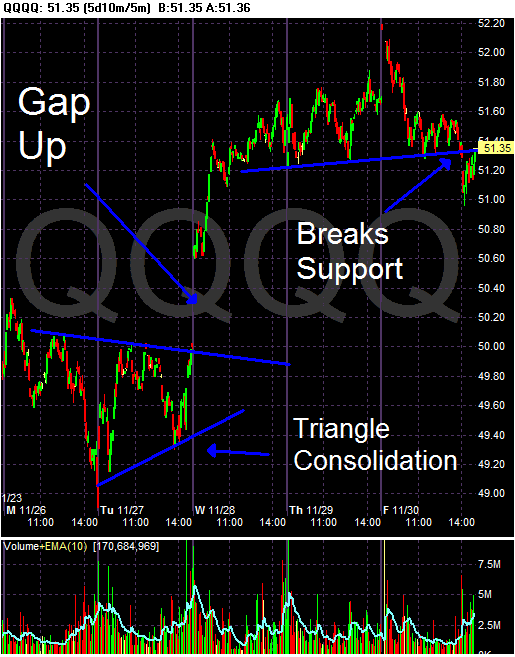
The QQQQs consolidated in a triangle pattern on Monday and Tuesday. They gapped higher on Wednesday then hugged a trendline for the rest of the week. Like the SPYs, we see strong buying at close on Friday.
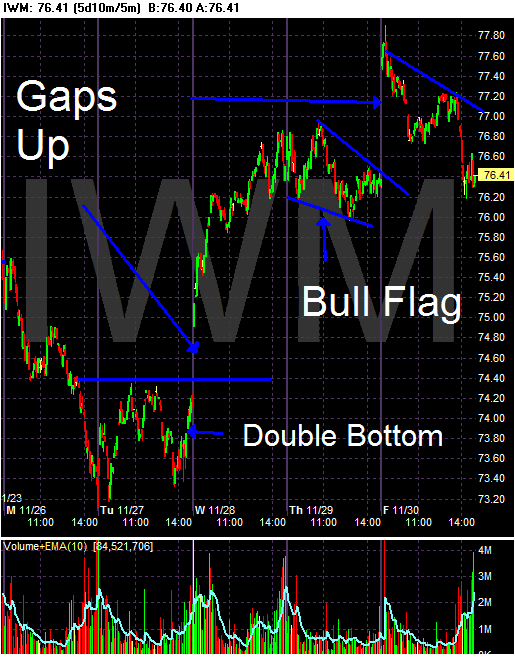
The IWMs (Russell 2000) also had a double bottom on Tuesday. They gapped higher on Wednesday, formed a bull market flag on Thursday and gapped higher at the open on Friday. However, they dropped for most of the day on Friday. However, they had a strong volume showing at the close of trade without much price appreciation.
What can all of these charts tell us?
1.) The markets are really messy right now. While last week's general trend was up, notice it was by fits and spurts rather than a nice gentle move upward.
2.) There were two upward gaps each on the SPYs and IWMs. Gaps mean there was a rapid change in sentiment. In other words, something pretty fundamental changed. That something was the feeling the Fed will cut rates. My guess is traders are no longer thinking 25 basis points but 50. That would support the radical moves we saw last week.
Let's go to the daily charts.
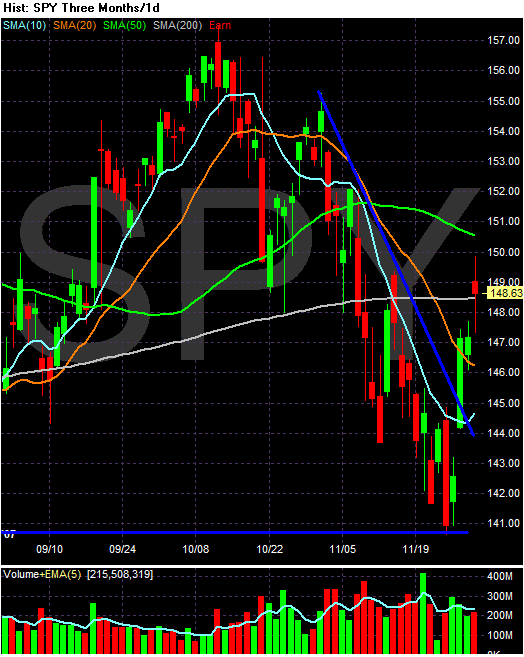
The SPYs broke their downward trend line and gapped up through the 10, 20 and 200 day simple moving average (SMA). That is one hell of a move. The SMAs will now provide support for the market which is good news for the bulls. Also note that volume was pretty good.
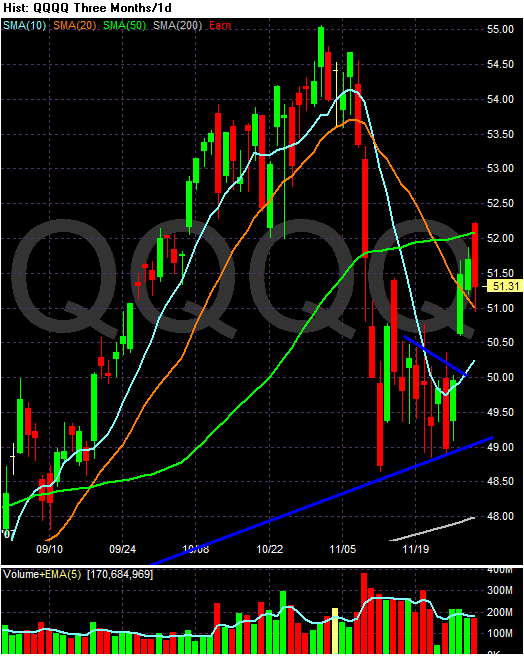
The QQQQs moved through the 10 and 20 day SMA last week. They also broke out of a consolidation pattern. They did run into upside resistance from the 20 day SMA on Friday. However, they also had a good move last week on decent volume.
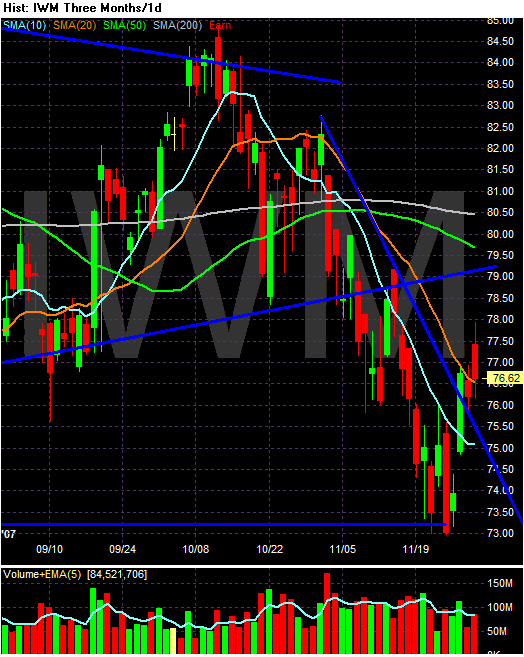
The Russell 2000 broke through resistance and the 10 and 20 day SMA last week. Volume was decent. However, this index is still trading below the 200 day SMA by almost 5%, so things aren't very rosy for this index.
I want to go back to Bernanke's statement for a minute. Remember, most of the time the Central bank gives us standard patter, like "the US economy is operating below potential, but the chance of negative fallout is small." Translation: we're not operating at full potential, but the sky isn't falling either.
Note the Bernake specifically mentions a lot of the major problems in the markets and the economy. That's pretty atypical. He notes declining equity values, increasing credit spreads, increasing writedowns, and increased short-term funding pressures. In short, Ben is basically saying things are really bad right now. As far as he is willing to be in public, it sure sounds like Bernanke is almost scared about what is happening. I could be wrong on that, but for him to come out and express his concern about all of those events is I think very telling.
The bottom line is I think the Fed's statements last week -- and Bernanke's in particular -- placed a floor underneath the market barring any really bad news. Bernanke's statements seem to indicate he is deeply concerned about the economy right now -- and there are plenty of reasons to be concerned. This concern would logically lead to a rate cut in the current economic environment.
UPDATE: Today's IBD makes the same conclusion:
The turnaround on Wall Street last week coincided with two reversals in Washington.
First, Federal Reserve policymakers started talking like doves, making clear that interest-rate cuts are back on the table. Then the Treasury Department picked up its bully club, setting aside its concerns about a heavy-handed approach to aiding subprime borrowers at risk of defaulting on their mortgages.
Fed Chairman Ben Bernanke said Thursday night that the economic outlook has been "importantly affected over the past month by renewed turbulence in financial markets."
While Bernanke said the Fed will be "exceptionally alert and flexible" in responding to incoming data, Treasury Secretary Henry Paulson has seen enough data to conclude that the housing market needs a stronger response from Washington.
Instead of encouraging lenders to provide forbearance to borrowers on a case-by-case basis, Paulson is now pushing the mortgage industry to provide broad-based relief. Treasury hosted a meeting with industry officials and financial regulators on Thursday, and reports said the details of an agreement could be announced by the end of the year.
IBD also highlights the Treasury's ideas for dealing with the mortgage crisis. I haven't formed an opinion about this plan. However, the markets are obviously encouraged that Washington is doing something. As with anything like this, the devil will be in the details.
Mish thinks the plan is doomed.